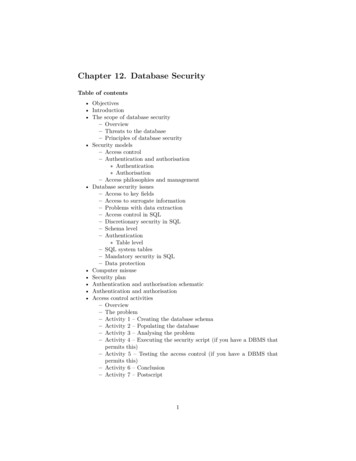
Transcription
Penetrum Security -- The Difference
Penetrum Security Analysis of TikTok versions 10.0.8 15.2.3TikTok is a mobile application in which users can view, upload, like, duet, and sharevideos with one another. This mobile application seems harmless, with 66% of it's usersworldwide being under the age of 30 years old, and within the US 60% being within the agerange of 16-24 years old ( emographics/ ). Seemslike fun making silly videos and memes, correct?However, 37.70% of the known IP addresses linked to TikTok are Chinese. On TikTok’sISP's privacy policy, they declare that they harvest and share your data with third-party vendorsand business partners ( https://rule.alibaba.com/rule/detail/2034.htm#AA ). What if I told you thatTikTok harvests an excessive amount of data and that this can all be proven right now? In thiswhitepaper, we here at Penetrum are going to prove that there’s an excessive amount of dataharvesting, some vulnerabilities in TikTok’s code, as well as a few things that may make youfeel pretty uncomfortable. Buckle up folks, it's about to get pretty wild. (All research will bepublically available for all to see at https://penetrum.com/research/ )
Overview:-37.70% of known ip addresses linked to TikTok that were found inside of APK sourcecode are linked to Alibaba.com; a Chinese sanctioned ISP located in Hangzhou.Alibaba’s privacy policy states that they share and distribute personal information of itsusersTikTok in itself is a security risk due to the following reasons;- Webview, and remote webview enabled by default- Application appears to take commands over text and receives them piping themdirectly into Java as an OS command- The application that uses Java reflection while decreasing VM load time can alsobe taken advantage of by malicious users and has a CVE score of 8.8- This application has been observed to log sensitive information such as;- Device information- User GEOlocation- Monitors user activity
Links to Chinese IP addressesNow it’s not a secret that TikTok is a Chinese mobile application, but just how much ofthis application is sanctioned and controlled by the Chinese? Well, according to our research,23/61 IP addresses (or 37.70%) are stationed outside of the US with a majority of them beingstationed inside of China and hosted by an ISP named Alibaba. Using the API from IPvoid andsource code from the APK we were able to extract around 61 unique IP addresses. From there weused IPVoid’s API to discover the information associated with them. Below is just a singleexample of what we received back:On the plus side, the IP address isn’t detected to be doing any nefarious activities, but thatdoesn’t change the fact that it is still inside of a Chinese controlled ISP. Now what we ask you todo is to keep this information in mind while we continue and come back to this shortly.
Alibaba’s Privacy PolicyHaving mentioned above about the Chinese connections, we need to get into exactly howAlibaba protects, and uses end user private information. To read fully on how it is processed andhow it is handled you can follow this link: https://rule.alibaba.com/rule/detail/2034.htm#AA ,which will take you to their disclaimers page. Let us highlight a few things about the disclaimersthat stuck out to us personally;-you will be asked to provide certain contact information that is necessary for the registering for a Platformaccount on behalf of a Buyer or Seller, including name, address, phone number, email address, job title anddepartment;-- We will collect details of user activities, transactions and interactions on the Platform including informationrelating to the types and specifications of the products and services purchased, pricing and deliveryinformation, dispute and complaint records, communications between users and any information disclosed inany discussion forum.We may disclose (or provide access to) personal information to the following categories of recipients:Third party business partners, service providers and/or affiliates of Alibaba.com engaged by us orworking with us to assist us to provide services to you or who otherwise process personalinformation for purposes described in this Privacy Policy or notified to you when we collect yourpersonal information. Categories of these partners or service providers include:cloud computing service providers to provide cloud storage services;third party rating / reviewing service providers to carry out reviews of our services with customers ifyou choose to participate in reviewing or rating Alibaba products and/or services;Now all of this seems pretty straightforward. That is, until you realize that Alibaba was forced toshut down their servers due to a massive data leak in or around July 2019( ut-down-server-after-data-leak/ ). A total of899GB of data was exposed to cyber criminals for over half a month. In that time Alibaba was( we assume ) cooperating with TikTok on a daily basis. This not only puts Chinese citizens injeopardy, but American citizens as well. Before this investigation, a few of us had been usingTikTok for well over a year, and we never heard anything about this 899GB data leak fromtheir Chinese hosting ISP how about you? Something from this leak that we would like topersonally highlight is the following paragraph (keep this in mind for later):If credit evaluation reports from the mobile loan apps weren’t bad enough, Anurag’s team alsodiscovered 4.6 million unique entries of device data, including GPS locations, full lists of mobile
contacts, SMS logs, IMSI numbers, IMEI numbers, device models and versions, stored app datafrom previous installations, and memory data (composition and content of mobile phonememory).TikTok and What Data is Collected
It is known that mobile applications collect data, which they use to generate income andfor targeted advertising for the end user. However, when does extracting data hit the threshold oftoo much? Is it necessary for a mobile application to harvest the IMEI number of a phone, it'sscreen resolution, or the SIM card provider information? Is it normal for an application to have asection that enables tracking, collects GPS coordinates, and more? In this section we will get intowhat data is collected by TikTok. (All code seen here is from version 15.2.3).The above image is pulled from the source code of TikTok (you can see all the code andthe ones specified by downloading our research at https://penetrum.com/research/ ), the abovesource code contains a tracker named AppsFlyer. AppsFlyer is, according to their website, a“ enterprise CRM-like SaaS platform that allows app developers to store, own, analyze, andcontrol their customers data ” ( vacy/ ). Thatbeing said, it is clearly stated in the code that they use it for monitoring. To what extent? We arenot sure, due to obfuscation and anti-VM precautions taken by TikTok after version 10.0.8. Whatwe can derive from the code is that when the variable shouldMonitor is set to true the application
enables a tracker. One of the tracking methods AppsFlyer uses is location data, which is used toprocess user location to produce location based advertisements.Continuing with the location tracking, the code above is also pulled from the APK sourcecode. The requested permission android.permission.ACCESS FINE LOCATION is used toallow the API “ to determine as precise a location as possible from the available locationproviders, including the Global Positioning System (GPS) as well as WiFi and mobile cell data. ”( ndroid-sdk/location ). The protection levelof this permission is labeled as “ dangerous ” and another permission (which is also requested bythe application) is given as an alternative to the use of this one.
Continuing on from here we come across this code, which is a file filled with dataharvesting. It collects everything from the current OS version to running network events (WiFiSSID changes, etc), and even the IMEI number of the associated phone. This is extremelyalarming to us due to what was said in the above data leak “ including GPS locations, full lists ofmobile contacts, SMS logs, IMSI numbers, IMEI numbers, device models and versions, storedapp data from previous installations, and memory data”, now we at Penetrum cannot make adirect connection to this breach and TikTok, but it seems very suspicious that the data collectedis mentioned in a breach that happened to their ISP provider. We understand that data is neededto be collected for the developers to thrive and continue producing good code for the application.But, where do we draw the line when it comes to too much data?
The above code taken from the TikTok APK, shows the collection of cellphone data,specifically the IMEI of the cell phone. The IMEI number of a phone is literally created toidentify the phone. The IMEI when used by trackers is usually used to determine whether anapplication is re-installed on a phone and give an analysis of other applications that are installedon the phone. Essentially, it creates an extremely realistic and graphic fingerprint of your phonewhich can be used to determine everything you have installed. Getting information like this hasbeen considered “ controversial” in multiple circumstances. Alongside the IMEI is the IMSIwhich is used to follow users while getting a new phone, basically while transferring your SIMdata to a new phone, the IMSI number stays with you. Tracking this number gives the tracker asolid understanding of your habits when it comes to phones and can give you more targetedadvertisements, and even create a profile on you for your next potential phone. We were not able
to say with 100% certainty that the IMSI number is also extracted, but it seems relevant to thecause of the tracker to also extract the IMSI number with the IMEI.Now we are not saying that TikTok is using these things for nefarious purposes in anyway, we at Penetrum believe that everyone should have the right to know what data is beingharvested by companies and would like to give our readers a clearer understanding of whathappens when you download the mobile application TikTok. From our understanding and ouranalysis it seems that TikTok does an excessive amount of tracking on it’s users, and that thedata collected is partially if not fully stored on Chinese servers with the ISP Alibaba. It seemsslightly coincidental to us that Alibaba’s data breach specifically states that the breach itselfincluded that IMEI, IMSI, phone numbers, and user data specifically pertaining to phones wasbreached as well as other personal information.
Security Concerns of Downloading TikTokIf the above information wasn’t enough to get you thinking about what TikTok is doingwith your information, or that the security needs to be seriously looked into pertaining toTikTok. Maybe us talking directly about the insecurities that arose during our analysis will getyou thinking. We will discuss the following insecurities:-Execution of OS commandsInsecure cryptography usagePotential SQL injection code from user defined variablesStoring of API tokensWebview enabled by default along with insecure webview enabled
Lets dive in by first examining the OS execution done by TikTok:The above code (and all code shown) was also taken from TikTok version 15.2.3. Thiscode is used to execute OS commands from inside of TikTok and is used a few times within theapplication to perform operating system commands. We are not entirely sure if the code is userdefined or not because our analysis was prevented from viewing activities performed on anyapplication version higher than 10.0.8. Now executing OS commands is normal andunderstandable, but executing them from user input is less acceptable. More research will need tobe done in order to make a concrete determination if TikTok executes from user input, but we areconfident that there is some issue on what is executed as an OS command.
Not only does the application execute OS commands, but it also uses insecurecryptographic algorithms, such as MD5:The hashing algorithm MD5 has been deprecated since at least 2011 along with SHA1.MD5 has been known to be a very weak hashing algorithm due to the speed and the ability tomake thousands of hashes very quickly in a bruteforce attempt.Not only do they use insecure hashing algorithms, but there is potential for a user definedSQL query as well:Everyone knows that you never give a user access to your raw SQL commands, this canbe a very bad thing, very quickly. The above code does exactly that. The arguments passed intothe code are user defined (we are not 100% sure where they are defined but think it hassomething to do with the profile editor), once executed they do not seem to go through any typeof sanitization and are executed to delete a column from a table.
TikTok seems to have a knack for hardcoding their information into the applications sothey will not have to retrieve it from elsewhere, for example:The above code is an example of TikTok hard coding API tokens into its code.Hardcoding tokens is not that big of deal, until you realize that they’re hardcoded into plaintextand are accessible throughout the entire application, that’s when it starts becoming a bigger dealthan it should be.Alongside all these issues we discovered that TikTok uses webview and reflection alot,when done correctly these do not bring up any real security threats, however:
The above code is just an example of how many times webview and reflection is usedwithin TikTok. Reflection can in theory make the latency and load on the Java VM quicker, butthe use of webview also has a very serious security risk associated with it that is ranked as an 8.8CVE score. During the course of analyzing this application, there were several concerning areasrelating to webview and its insecure use of SSL/TLS like ignoring SSL/TLS errors all together,reflection, or REMOTE DEBUGGING a s captured here:
As well as here:Allowing user defined commands to be executed within webview has the potential to leadto arbitrary files being loaded on the device that is hosting the application. Which in theory canlead to malware being loaded from inside the application, chained with remote debugging to seewhat fails in your malware. It also allows a very big window for attackers to not only upload, butexecute, and debug their malware as well(in almost real time). To us here at Penetrum this seemslike an extreme security risk that shouldn’t be taken lightly. It is also good to note that webviewis implemented in such a way, within the application, that it ignores SSL errors which means theauthenticity of the sender/client cannot be established . Meaning anyone who figures out howto enable and leverage this capability of this app, can use it or execute man in the middle attacks.This can be seen within our static reports at https://penetrum.com/research/ .
ConclusionAt Penetrum, we strive to provide the most detailed, transparent, and accurate securityanalysis and audits that are within our ability. We also strive to develop the most ambitious, yetpractical cybersecurity tools and use them in the field. After extensive research, we have foundthat not only is TikTok a massive security flaw waiting to happen, but the ties that they have toChinese parties and Chinese ISP’s make it a very vulnerable source of data that still has more tobe investigated. Data harvesting, tracking, fingerprinting, and user information occurs throughoutthe entire application. As a US company, we feel that it is our responsibility to raise awareness ofthis extensive data harvesting to TikTok’s 1 billion users.For more in depth information on this issue, check out our research athttps://penetrum.com/research/ .We appreciate you taking the time to look through our research and appreciate youtaking the time out of your schedule to read our whitepaper. We’ll see you then.Penetrum - The Difference
Penetrum Security Analysis of TikTok versions 10.0.8 - 15.2.3 TikTok is a mobile application in which users can view, upload, like, duet, and share videos with one another. This mobile application seems harmless, with 66% of it's users worldwide being under the age of










